Have you ever tried navigating a city without a map or GPS? If so, you likely found that just driving around aimlessly isn’t very effective in getting you to your destination. The key to success lies in understanding your current location, knowing where you want to go, and having a clear route.
Similarly, in business, having a strategy is essential. It guides your decisions, helps you allocate resources effectively, and keeps you focused on your goals, ensuring you reach your destination successfully.
Therefore, the business analysis process is the first step in introducing any kind of digital transformation implementation initiative, whether developing a new software solution or transforming the entire company.
This post is a brief digital transformation guide that explains how to transition a business to the online environment and how to get started.
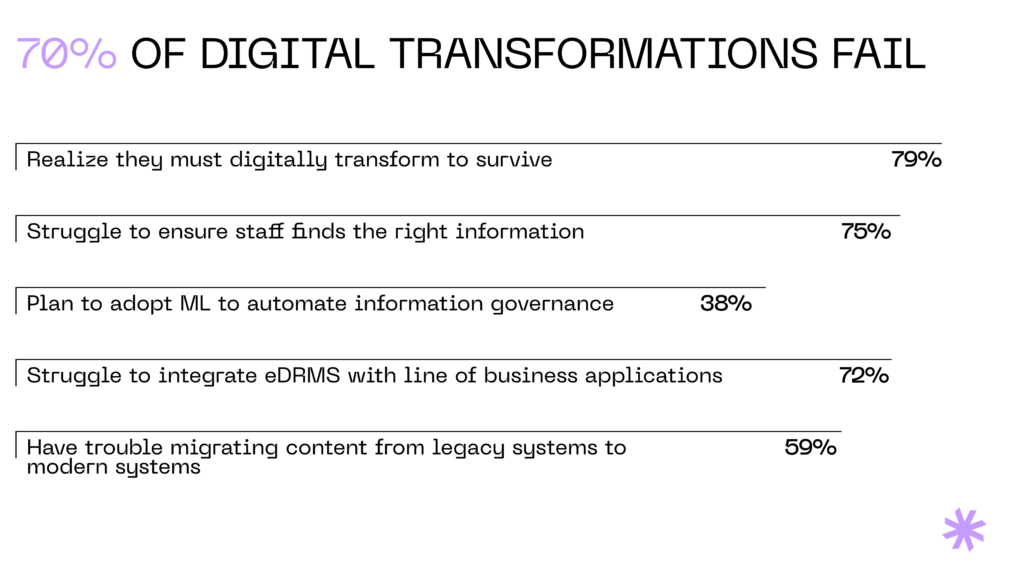
What is digital transformation?
Digital transformation (DT) is introducing digital technology to assist a business in producing products, providing services, or maintaining operations. It often changes how an organization operates and delivers value to customers. The process is different for every business, but usually, it requires walking away from traditional practices to relatively new ones through experimenting.
Digital transformation implementation examples are:
- A shift from in-person banking to mobile banking, cardless payments, and finally, bankless banking;
- Using technology, such as ML/AI, cloud computing, big data, IoT, AR, and others, to improve sales efficiency;
- Using design thinking to optimize and improve customer experience;
- Automating customer service and more.
Worth noting that enterprise digital transformation is not about introducing new technologies into existing processes. It is about finding ways to tackle business challenges better. Digital tools are used to aid this purpose, but they themselves are not the goal.
In this post, we will also cover the recommended steps to implement digital transformation successfully and with minimum waste.
Now, let’s discuss why a business might want to start transforming.
Benefits of digital transformation for business
Changes are hard and risky, so many companies are still hesitant to transform their business processes around digital technologies.
However, they need to recognize that market globalization and changes in demographic preferences make digital transformation inevitable.
Furthermore, they miss out on the tangible benefits described below.
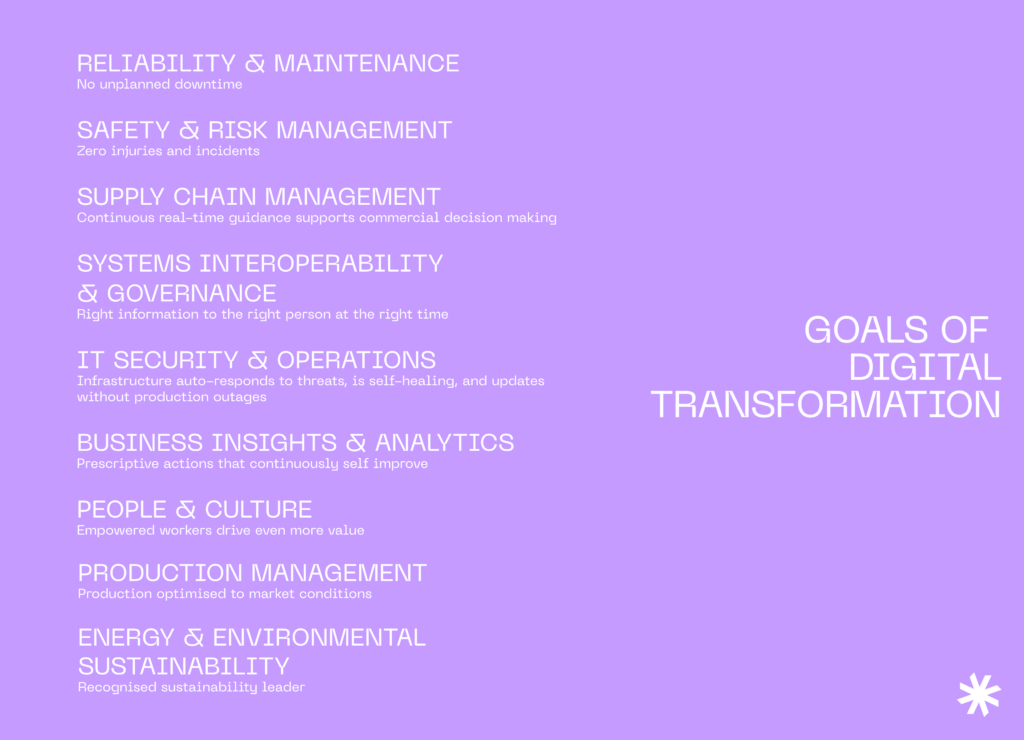
Data-based decision-making
Data analytics tools can optimize the collection and storing of data that you can turn into revenue-generating insights. Moreover, advanced technologies can help you create a system to search for the correct data and provide a single view of the customer journey, production, operations, finance, and business processes.
Improves customer experience
AI, AR/VR, and IoT can create a seamless shopping experience by tying online and offline touchpoints and creating an omnichannel experience. Many businesses already use chatbots to engage with more customers and provide personalized service. However, you can do much more and automate the checkout process in your store, help customers envision your products in their homes, provide expert consultations, etc.
Improves monetization
A good digital transformation strategy simplifies the move from product-centricity to customer-centricity, forcing a more value-based approach to pricing. Thus, you’ll be able to determine the customers’ needs and willingness to pay and decide on the product’s design and functionality based on that.
Next, you can define a better commercial strategy with more in-depth customer data.
Encourages collaboration
Digital tools connect people across the distance and provide access to massive amounts of data to support conversations. Traditional phone calls and emails cannot beat the video, audio, and data working synchronously to reach a responsible person quickly.
Moreover, the ability to create private channels granted by many business communication tools lets you safely connect the inside and the outside of your organization.
Increases Agility
The digital environment can help your business improve speed-to-market and adopt a Continuous Improvement (CI) strategy. This will allow you to anticipate challenges, innovate faster, and better adapt to trends while constantly improving your offers and processes.
Can your business scale?
We’ll help you assess your current processes and create a step-by-step transformation plan to solve your challenges. Outline your problem in this form.
Write to usImproves customer satisfaction
A digital transformation strategy helps teams work better through streamlined processes, centralized data, and transparent communication. Technology also removes a lot of manual work that positively impacts customer satisfaction. Put simply, customers no longer have to wait for someone to come and, say, update their software.
Eliminates human error
Using advanced cybersecurity solutions shields users from threats that prey on human error, such as phishing emails. In addition, automated solutions reduce the number of repetitive tasks, limiting careless mistakes that can be costly.
Improves operational efficiency
Any business will excel with automation reducing the need for manual data entry and increasing cost-efficiency, flexibility, and decision-making. Then, digital transformation helps uncover opportunities and new markets you might not have had access to before. Finally, a proper digital environment within an organization is a significant talent attraction.
Provides better resource management
Since digital transformation implementation encompasses every business area and unit, it will help you unify company resources and identify overlaps. You can reduce the number of applications, databases, and other software by integrating all tools and flows into a central repository.
How does Syndicode help drive digital transformation?
Syndicode is a digital transformation company that helps businesses create and execute their digital transformation strategies.
HLPRS is one of our recent projects and an example of an established business anticipating a change in customer demand due to digitalization. This B2C home services marketplace introduced automation to accelerate its business process, enhance productivity, and increase the number of customers.
The Syndicode professionals helped HLPRS optimize user experience by bringing in nearby helper search, calendar view, automated new candidate search, and helper rating system features. It accelerated the hiring process and improved turnover tremendously. What’s more, the client could scale their business without expanding overhead costs.
In addition to the technologies used in the HLPRS project, our engineers are proficient in ML, AI, IoT, and cloud computing.
Main areas of digital transformation
The adoption of new technologies significantly impacts a business’s operations. Along with the anticipated benefits of digital transformation—operational improvements, increased collaboration, and improved customer experience—organizational structures and employee performance also change.
Businesses should focus on four main focus areas during digital transformation implementation: business processes, business models, business domains, and business culture.
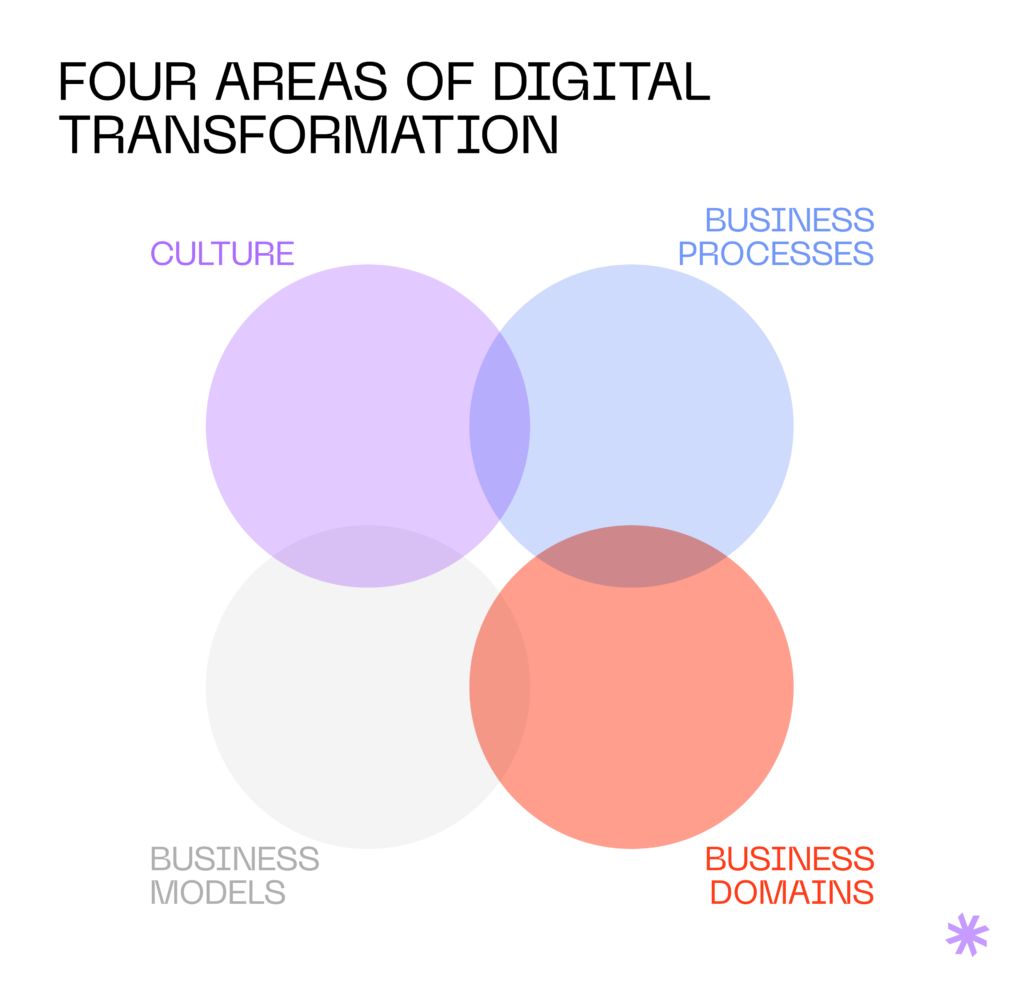
Process transformation
Business process transformation is required for a company to use its resources and discover opportunities more efficiently using technologies. Often, it involves automating or improving existing processes.
For instance, process transformation may include introducing automated manual data entry in administrative functions. Another example is creating an online app for consumers to specify their size so that a clothing store has the respective items available when they come to try them on.
Here is the sequence to follow to create a successful digital transformation strategy:
- Define goals to be entirely sure of what you’re going to achieve;
- Assess current processes to understand how they currently work and how they can be changed;
- Determine the right solution to implement, and ensure it fits your objectives and needs
- Support the change by communicating the transformation plans to stakeholders, providing training, and making adjustments to achieve goals more effectively.
Business model transformation
Digital transformation of a business model shifts a company’s focus regarding target audiences, engagement strategies, and expenses. A business might change its business model to increase profit and turnover, leverage new technology or market description, etc.
For instance, PayPal repurposed its technology, which was once aimed at cryptography services, and created a digital wallet to attract interest. Similarly, Netflix transformed into an online streaming service provider from a mall-based DVD rental business.
There are many ways to transform your business, but the first step is always to understand your goals and create an action plan.
Domain transformation
Businesses looking to move their operations and data to the cloud undergo domain transformation. Before you execute your digital transformation strategy, you must identify the workloads and applications that will work in the cloud. Besides, ensure that:
- All data is safe;
- The cloud provider meets your goals and needs;
- You have a clear migration plan.
Cultural transformation
Transformations in all areas mentioned earlier inevitably lead to the misalignment of a company’s current culture with its new mission, objectives, and values. Therefore, a change is necessary to remain competitive in the employment market and maintain high employee retention and talent attraction rates.
The following things will help leaders fight resistance and carry out their digital transformation strategy successfully:
- Articulate the desired culture and be a role model for the new behavior;
- Give time and resources for the transformation to take root;
- Focus on critical shifts;
- Identify and remove barriers that drive the resistance.
Improve your business outcomes
Rekindle your business growth with digital transformation services by Syndicode. Our experts will help you create a strategy for utilizing technological advances to improve your sales and marketing returns.
Talk to salesSteps to digital transformation implementation
You know where you want to go – increased productivity, improved efficiencies, and reduced costs, to name a few. But what is a good digital transformation strategy, and where to begin?
We suggest asking yourself the following questions:
- What are the most urgent issues to be addressed by digital transformation?
- What is the expected business value gained from transforming a process, and how quickly will an ROI be seen?
- Will the existing applications be able to continue meeting business goals while they are being replaced?
- What can go wrong during the transformation process, and what can go wrong if you hold off?
Remember that digital transformation implementation does not happen overnight; it is a gradual process, individual for every business. Still, the following stages of digital transformation will help you remain focused.
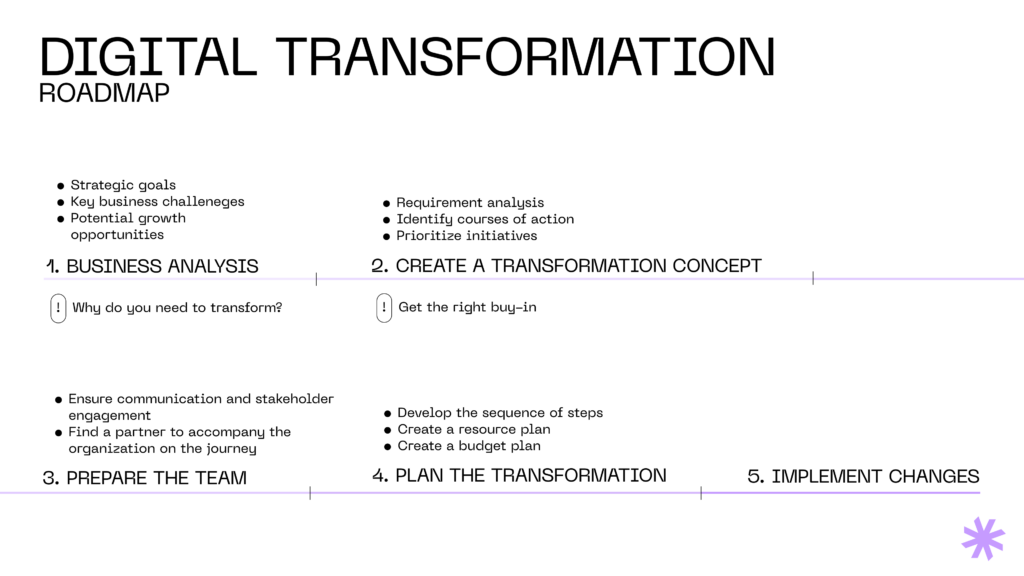
Step 1. Conduct business analysis
Going through an enterprise digital transformation process, the company still has to perform daily operations. These may include customer support, order processing, logistics, etc. Therefore, to maintain the current experience, your digital transformation strategy must contain a preparation stage.
- Start with research. Understand what digital transformation entails for your company and what resources it requires;
- Determine pain points. Outline the most problematic fields that urgently need transformation. Customer reviews and employee interviews usually provide the most insights.
- Prioritize customer satisfaction. Your customers must receive the usual service despite the changes you’re setting for. Otherwise, you’ll lose them. Thus, while preparing a new design for your company website, you must still reserve the resources to maintain the current version until the redesign is completed.
Step 2. Start a lighthouse project
Implementing digital transformation involves many moving parts. Changing one aspect of your organization will inevitably affect the others and may put current profits at risk. Trying to mitigate the risks often slows down innovation to the point where it turns into merely streamlining existing operations.
A focused lighthouse project can answer this challenge. It is a short-term big-picture project that serves as a model for similar bigger-scale initiatives. It allows you to prove your idea’s value and scale over time quickly. At the same time, failure won’t cause any devastating consequences.
Ensuring the success of a lighthouse project requires several considerations. First, it should be able to achieve its goals fast, even if it compromises quality. The goal is to prove your idea is feasible, not to deliver the best possible solution.
Second, it must be focused, i.e., have a particular goal to achieve. Chances are, though, that your organization needs more than one large-scale initiative so that you will have several small projects. Make sure that their goals do not overlap. Otherwise, it will be difficult to work out each project’s value and limitations.
Finally, you need metrics to prove the project’s value. Remember that lighthouse projects are narrow-focused, so their yield will rarely benefit everyone in the company directly. Ensure that the chosen metrics are clear enough to help you report on the findings on the company-wide level.
Now, you can apply what you’ve learned from your “digital experiments” and stakeholders’ feedback to your digital transformation strategy and start reimagining the existing business models.
Step 3. Prepare your team for the transformation
Employees’ reluctance to change may significantly slow down digital transformation implementation. Hence, it’s crucial to prepare your team through effective communication.
- Back your claims with statistics. Explore market trends and statistics, gather references, and use them to explain your point to the team and convince them about your strategy;
- Encourage experience sharing. Team members can provide a unique perspective on pain points that you might not have considered;
- Assign roles. People tend to value their own work more, so keep everyone in the loop by encouraging them to invest in the company’s digital transformation strategy.
Step 4. Create transformation plan
Once you’ve determined the transformation area and introduced your team to the concept, it’s time to create a system that covers both the global change and iterations dedicated to particular pain points.
We recommend executing a digital transformation strategy in chunks. This way, you can avoid sporadic and overwhelming change and instead make continuous improvements. Moreover, an iterative plan makes you more flexible in identifying and addressing issues.
To track your progress, set metrics that align with your transformation goals. KPIs will also help you identify the best-case and the worst-case scenarios and manage your expectations adequately.
Step 5. Implement changes and optimize
After having implemented a specific change, collect feedback and measure the success. Survey people impacted by the change and determine whether users outside the core stakeholders noticed any changes in your services. Then, you’ll be able to refine the digital transformation strategy to avoid shortcomings.
As soon as your company starts seeing results, you can leverage success and scale your business. You’ll notice new trends, technologies, and customer needs to consider in your next transformation round.
Why do digital transformation projects fail?
While global spending on digital transformation implementation is predicted to reach $2.9 trillion by 2025, it is merely a cost center for 28% of organizations.
Poor planning and a culture of resistance are the most common reasons for digital transformation to upend expectations. Let’s discuss these in more detail.
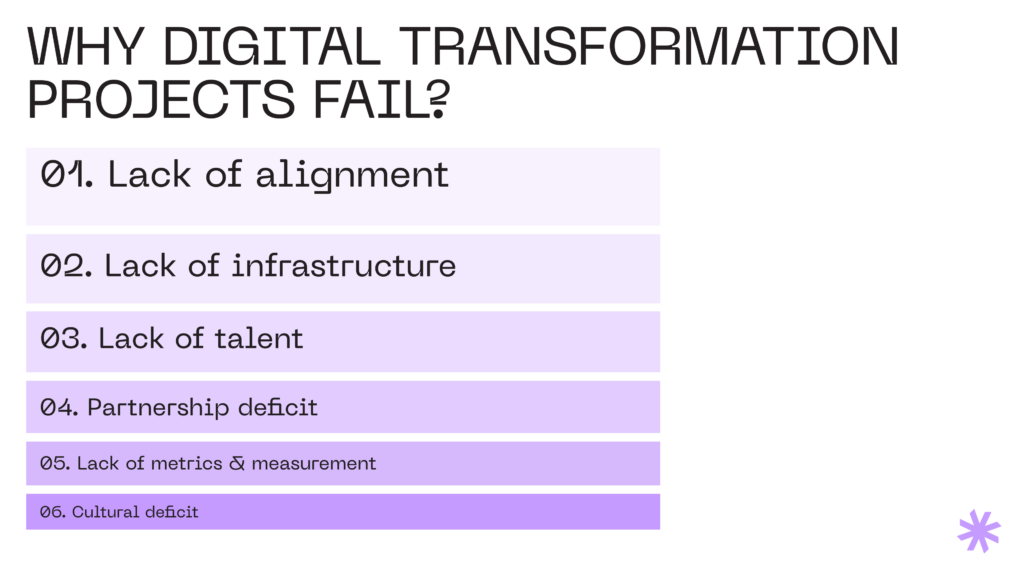
Unclear goals
Often, digital transformation implementation boils down to solutions that look for a problem to solve to make a company look futuristic and positive. This may happen because a company attempts to catch up with a competitor and fails to investigate its internal needs.
As a result, there are no clear goals to guide the digital transformation and no metrics to measure success.
An example of failed digital transformation use cases is Hershey, an American chocolate dessert brand.
In 1996, the company tried to replace its old IT systems with a new ERP solution. The transition to new systems was supposed to take 48 months, but Hershey’s leadership reduced the timeline. Eventually, they lost over $100 million in orders due to ERP problems.
Apparently, Hershey’s management underestimated the importance of testing and considered the transition a transformation for its own sake.
Lack of change management strategy
A change management strategy determines how a company’s day-to-day operations will go until the transformation is completed. It also considers the technical legwork needed to migrate successfully to new technology and shows which corners must not be cut to accelerate the transition.
Thus, in 2003, HP lost around $160 million in revenue and delayed orders when the company tried to unify its IT systems to run on one ERP.
They had a detailed digital transformation strategy and specified the time needed to fix any issues. However, they didn’t have manual workarounds to process orders while their ERP system was busy migrating.
Internal resistance to change
McKinsey states that 70% of change programs fail mainly due to employee resistance. Indeed, nearly 50% of employees are dissatisfied with their workplace technology. In many cases, though, better training could solve the problem.
Another reason for slow technology adoption is the lack of shared vision between departments. If your sales team focuses on closing deals, whereas marketing wants to attract more traffic regardless of conversions, it is hard to assess the success of the business’s digital transformation.
Finally, if the company leadership doesn’t fully understand the need for a new solution, digital transformation implementation doesn’t receive the necessary support and is deemed to fail.
The lack of internal support condemned MillerCoors’ attempt to simplify the company’s supply chain operations to failure in 2013. Among other mistakes, they failed to get expert advisors to oversee the transformation, guide the implementation, and report on issues.
Outsource to drive your transformation
Syndicode’s experts will help you tie your digital transformation strategy to your business goals and implement and support the change.
Start a projectHow can a business analyst increase the chance for success?
A business analyst processes data to form business insights and recommend changes to a specific organization’s part or an entire business. Their typical responsibilities include:
- Identifying a company’s functional and technical needs;
- Analyzing data;
- visualizing data;
- Understanding business strategies, goals, and requirements;
- Forecasting, creating financial models, and performing analysis to support business decisions.
But how hiring an IT business analyst can make digital transformation implementation easier? Here are four things that a BA does in a DT project.
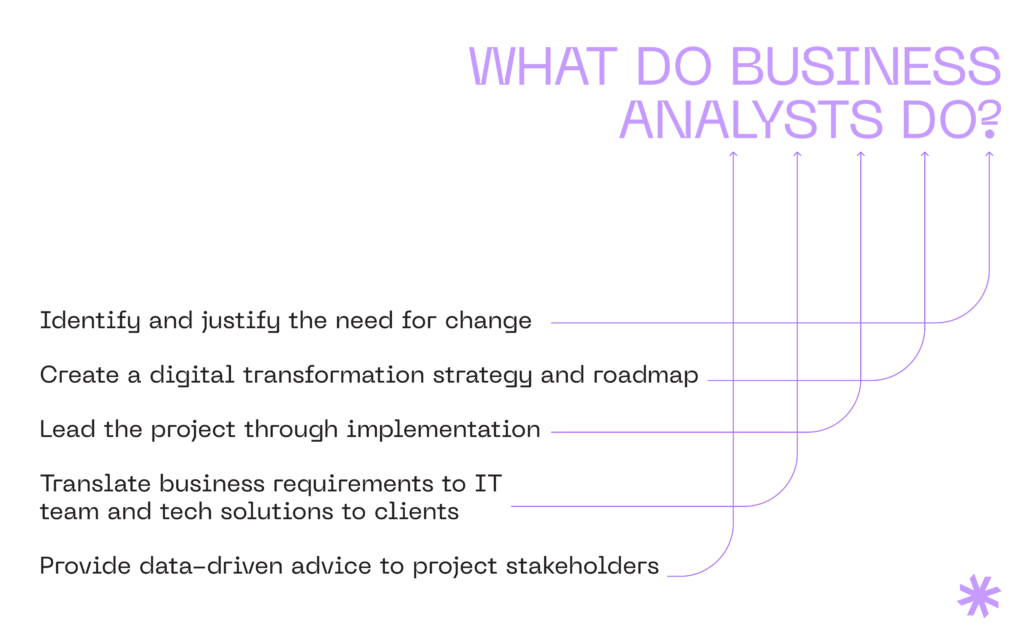
Clarifies the need for change
A business analyst identifies and interprets data needed to inform decisions that have a far-reaching impact on a business. They can thus determine the underlying reasons for an organization’s problems and justify the need for change.
Moreover, a business analyst can confirm the company’s theory about the transformation’s outcomes or suggest alternative ways to reach business objectives based on data.
For example, if an enterprise wants to move from on-premises to the cloud, the BA will define the potential issues cloud hosting will solve. Then, they will list all the business aspects impacted by migration and brainstorm risk mitigation strategies.
Aligns the transformation with the business strategy
Company leaders usually have a high-level vision of digital transformation implementation. A business analyst can help create a step-by-step plan and develop a timeline.
This way, objectives and targets stay within focus so that no initiatives that conflict with business strategy can take place and harm the transformation process. In addition, the role of a business analyst is to monitor progress and provide resources to team members so that everyone knows their task.
Bridges gaps between teams
A business analyst assists technical teams in understanding business needs and translating them into technological solutions. In simpler terms, BA experts speak both business and IT languages and help avoid frustrations when communicating key insights.
Besides, they establish transparent communication lines between IT and executives to encourage cooperation and avoid micromanaging. For instance, they will conduct a cost-benefit analysis of management’s proposal and suggest a rational, data-driven solution within the IT department’s capabilities.
Ensures customer-centricity
A business analyst ensures that everyone who will be affected by the new technology has a say in the decision-making process. This helps prevent mistakes, such as creating a solution that is unsuitable for specific people and losing money.
For example, a business analyst will identify the users’ needs and concerns, capture the business requirements, and establish acceptance criteria. This ensures a user-centric design and helps stakeholders keep up with the transformation progress.
Become one of the 30% that succeed in digital transformation
We focus on an incremental and cost-effective approach. Our experts will help you create a clear strategy, put people in the right places, guide implementation, and monitor progress.
Describe your projectHow long does digital transformation take?
The pace of digital transformation varies depending on a company’s initial level of high-tech application and its sector. Other factors, such as company leadership’s position, size, and target customers, can present additional opportunities or challenges.
Thus, media and finance businesses have already begun using digital technologies in their everyday processes. That means they will likely achieve their digital transformation goals sooner than a public organization which is among the sectors with the least technology adoption.
Next, the smaller the business, the more likely it is to lack IT experience. On the other hand, large corporations need more time to get buy-in from all stakeholders, which slows down the implementation.
That said, digital transformation implementation may take 2-5 months or years, depending on your situation and what you’re trying to achieve. That’s why it’s crucial to find a reliable digital transformation company that will help you overcome tech challenges while ensuring focus on your company’s identity.
Measuring the ROI of digital transformation efforts
It is hard to assess the return on investment since digital transformation implementation doesn’t happen in one sitting. However, you can use the traditional method and calculate the cost of owning and running the existing IT system, plot the cost of implementing a new system over several years and compare the two.
Thus, existing costs typically include:
- Hardware costs (servers, cables, storage, etc.);
- Software costs (operating system, application maintenance, and licensing);
- Associated software costs (e.g., database maintenance);
- Employee costs (to run the system and also training);
- Hosting costs;
- Security-related costs (backup software, hardware, and storage);
- Power, cooling, lighting, etc.
Transformation costs will differ depending on the organization, but it’s worth considering the following:
- The cost of owning and running new hardware (if applicable);
- The cost of licensing and maintaining new software;
- Migration costs;
- Employee costs.
The tricky part here is to estimate the cost of using a legacy system which will incur increasing costs yearly.
Final thoughts
Digital transformation is a broad term associated with many advanced technologies, and it’s unique for every business. However, it is always a dramatic change that requires rebuilding the business core.
Introducing new technologies requires adopting a different point of view and can backfire if taken up on a whim. Business analysis techniques can help identify and justify the need for change and verify the value of transformation.
If you are about to start implementing a digital transformation project or need help mid-term, our business analysts will help you develop a reasonable strategy. They will lower the implementation costs and ensure the resulting system’s usability and expandability.
Frequently asked questions
-
How business analysis help digital transformation?
Business analysis techniques help to assess current business processes, determine requirements, and create data-driven recommendations for a winning digital transformation strategy. BA specialists navigate the digital transformation process by aligning stakeholder requirements with company goals and capabilities. They also ensure focus on the big picture while articulating tasks and objectives to staff members. Overall, the business analysis process helps ensure the goals of digital transformation are reached and implemented on time.
-
What technology is used in digital transformation?
Enterprise digital transformation can involve any technology, but the hottest are Artificial Intelligence, cloud computing, big data, and the Internet of Things. It’s worth noting that digital transformation is not just about technology; it changes business processes and corporate culture to help organizations use technologies to compete with rivals.
-
How an Agile approach supports digital transformation?
An Agile process emphasizes the test-and-learn approach, iterative development, collaboration, and quality over rules. This methodology encourages learning and adapting. It is also heavily customer-centric. The biggest challenge of digital transformation is learning new tools, dealing with budget constraints and resistance to change, and adapting to changing customers’ needs. Therefore, Agile offers a low-risk solution that splits the transformation into short phases where teams quickly implement a solution to test a hypothesis, learn from the results and move on.
-
What’s the difference between digitization, digitalization, and digital transformation?
Digitization means converting information from analog to digital format that a computer can process. Creating spreadsheets based on ink-on-paper records is one example of digitization. Digitalization refers to using digital files in business processes. For example, keeping documents in the cloud so that all employees can access real-time data. Finally, digital transformation entails integrating digital technologies into the entire organization flow to create new value. Embedded banking is an example of digital transformation in financial services. It automates payroll systems, invoices, reconciliation, and integration with apps, wallets, etc.
